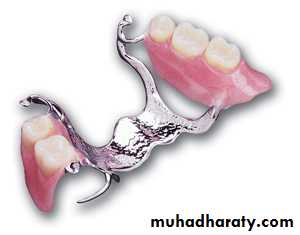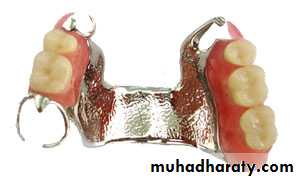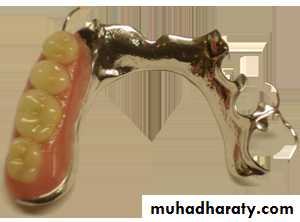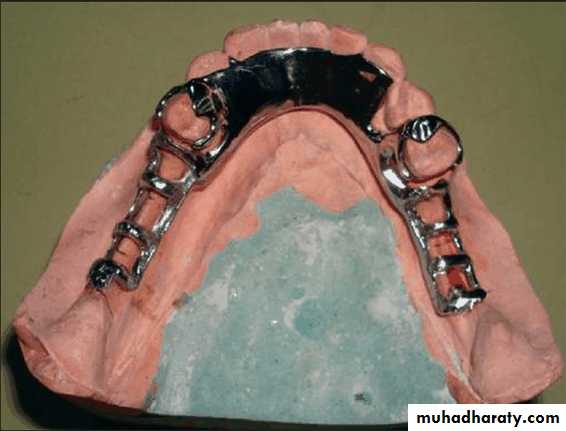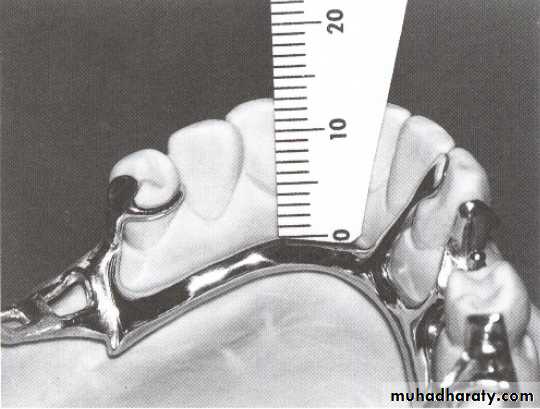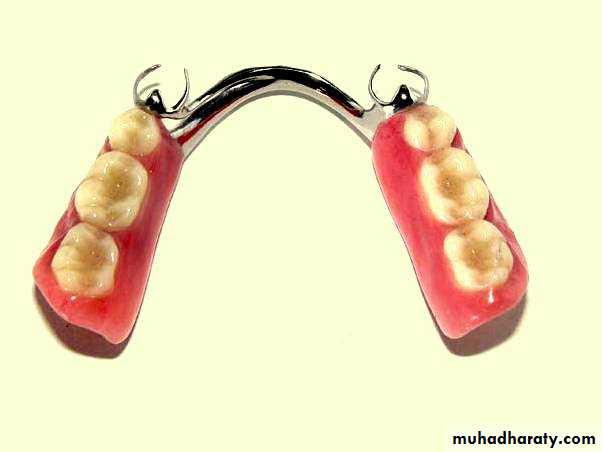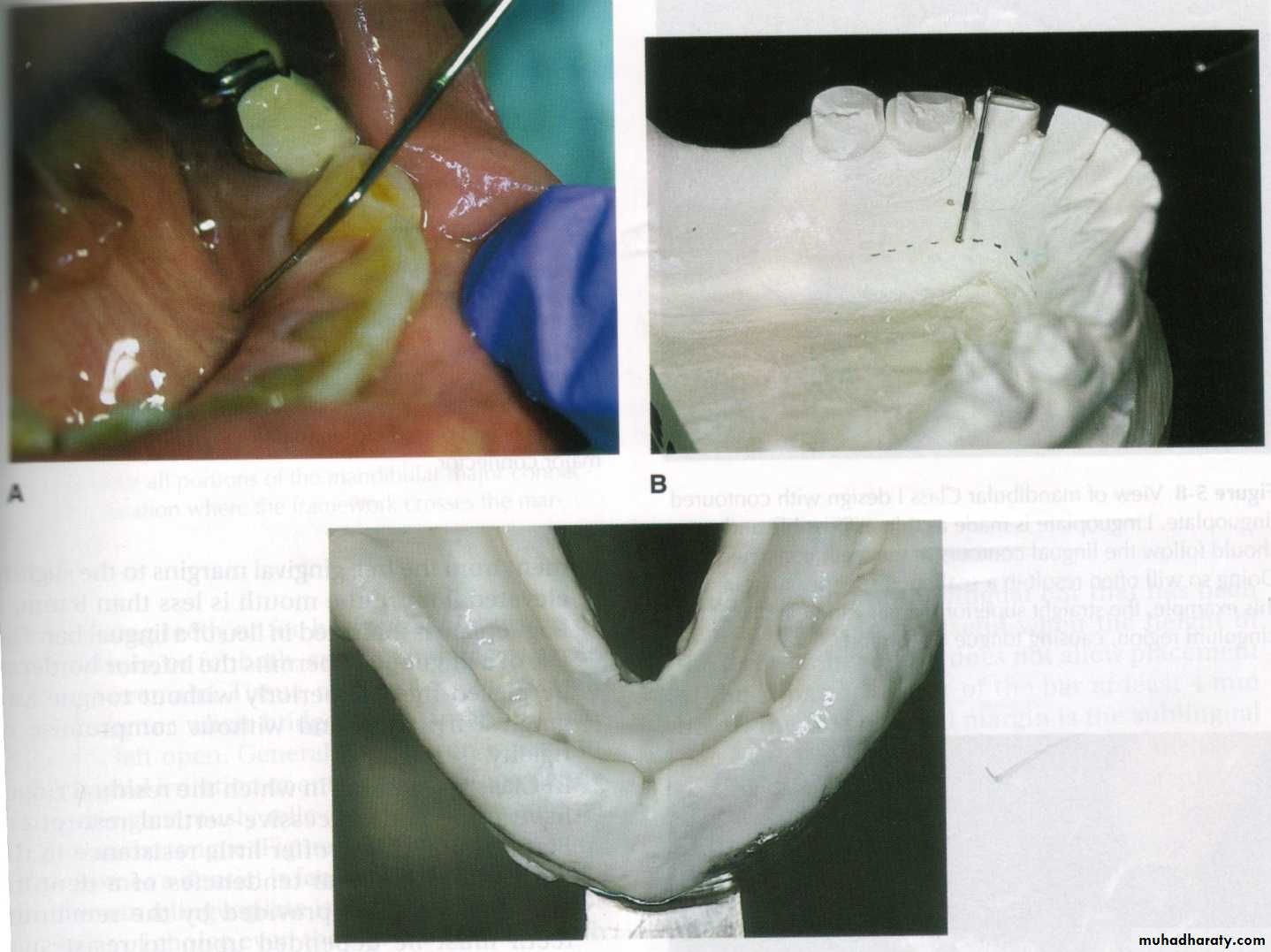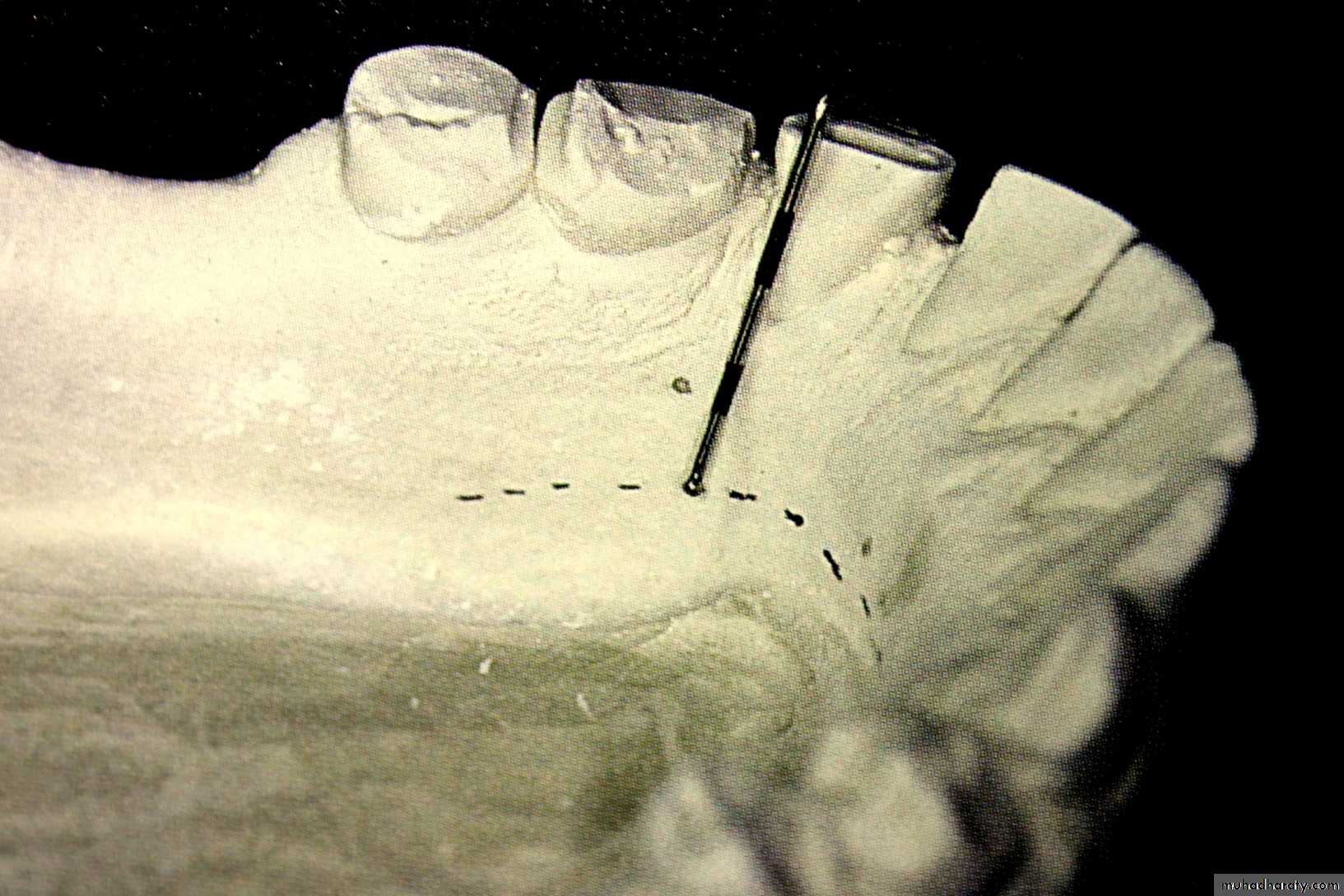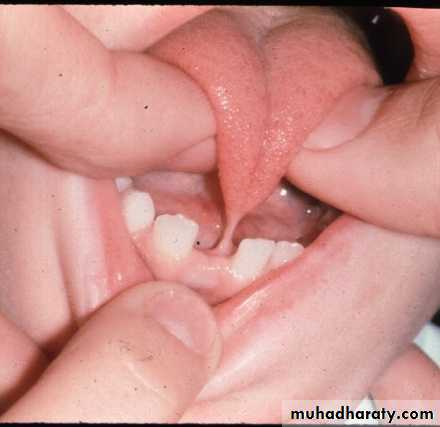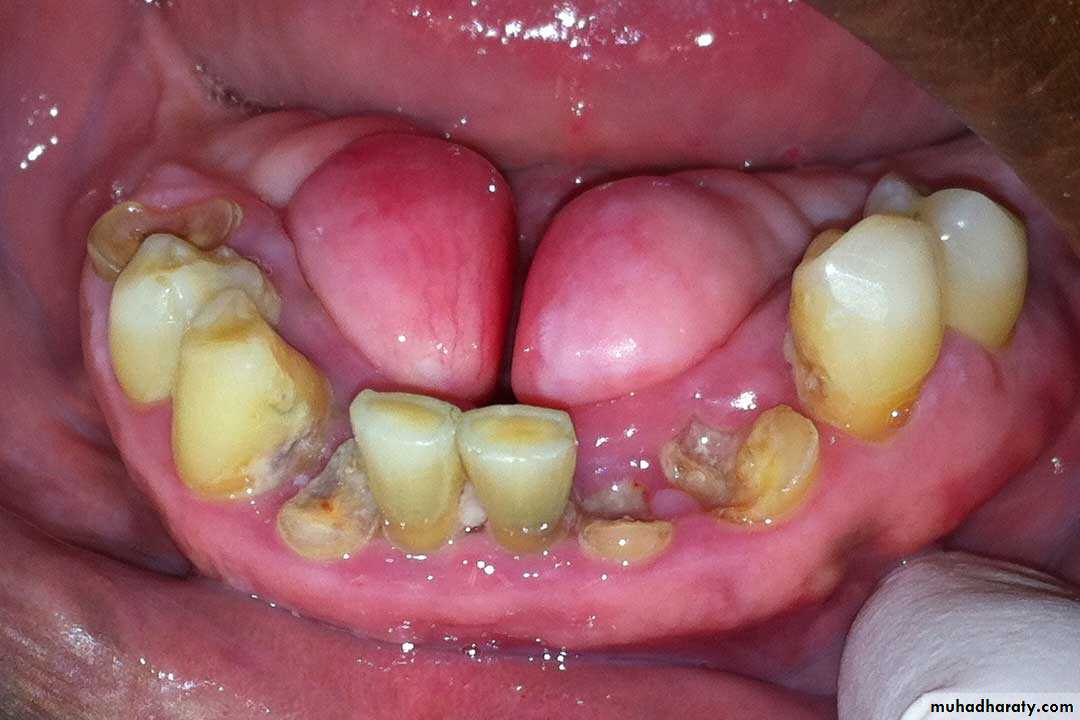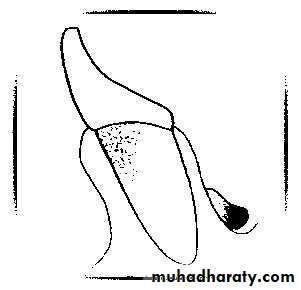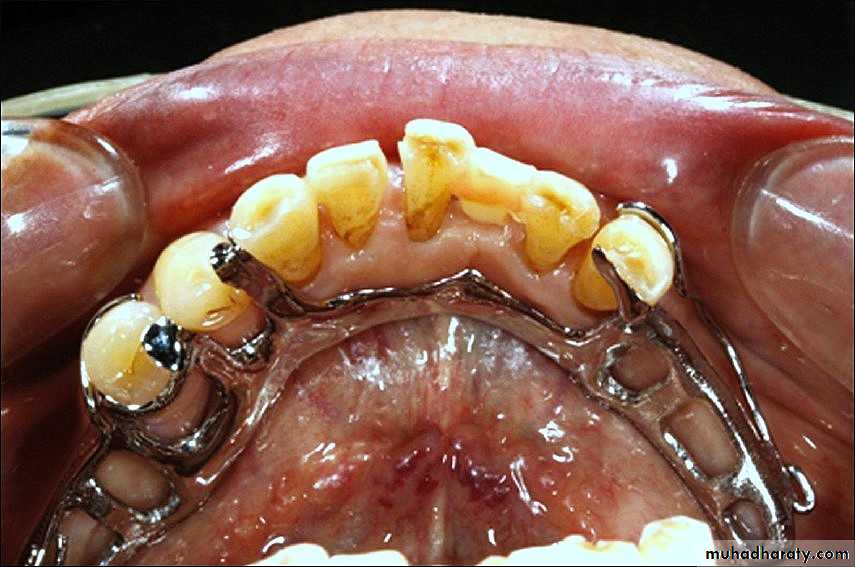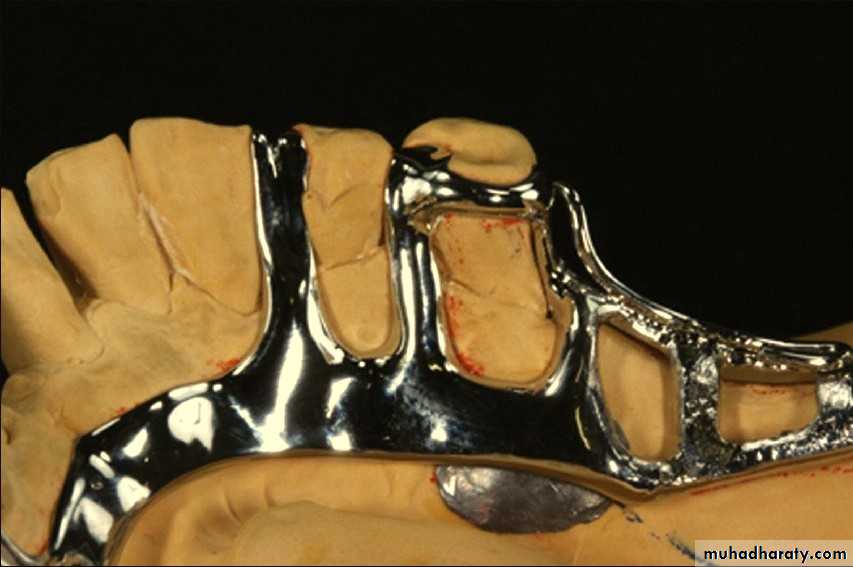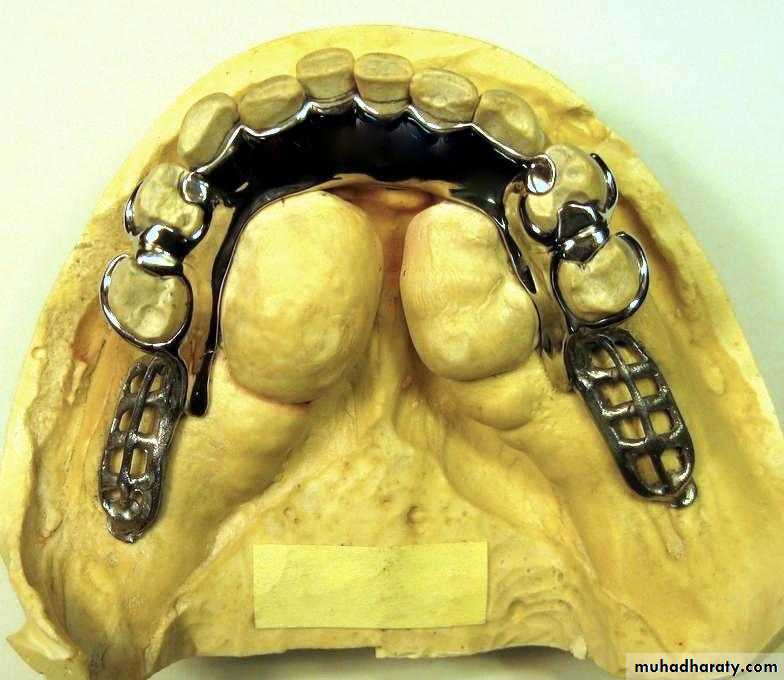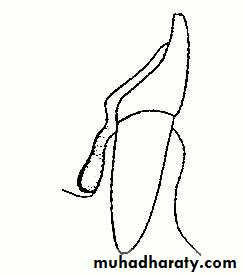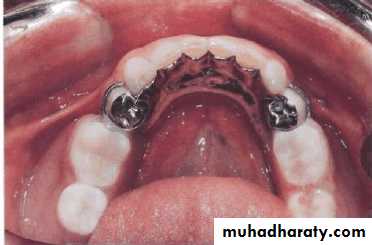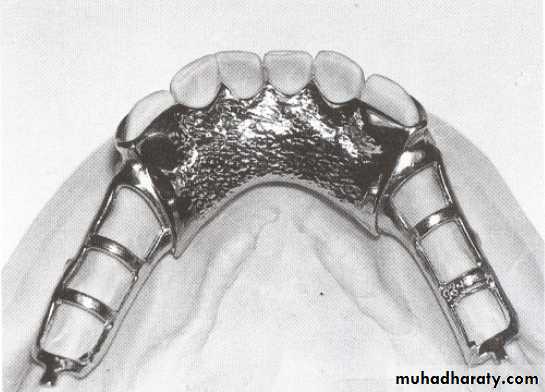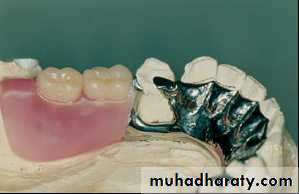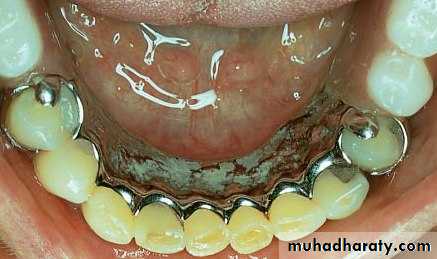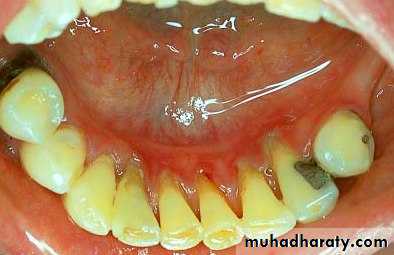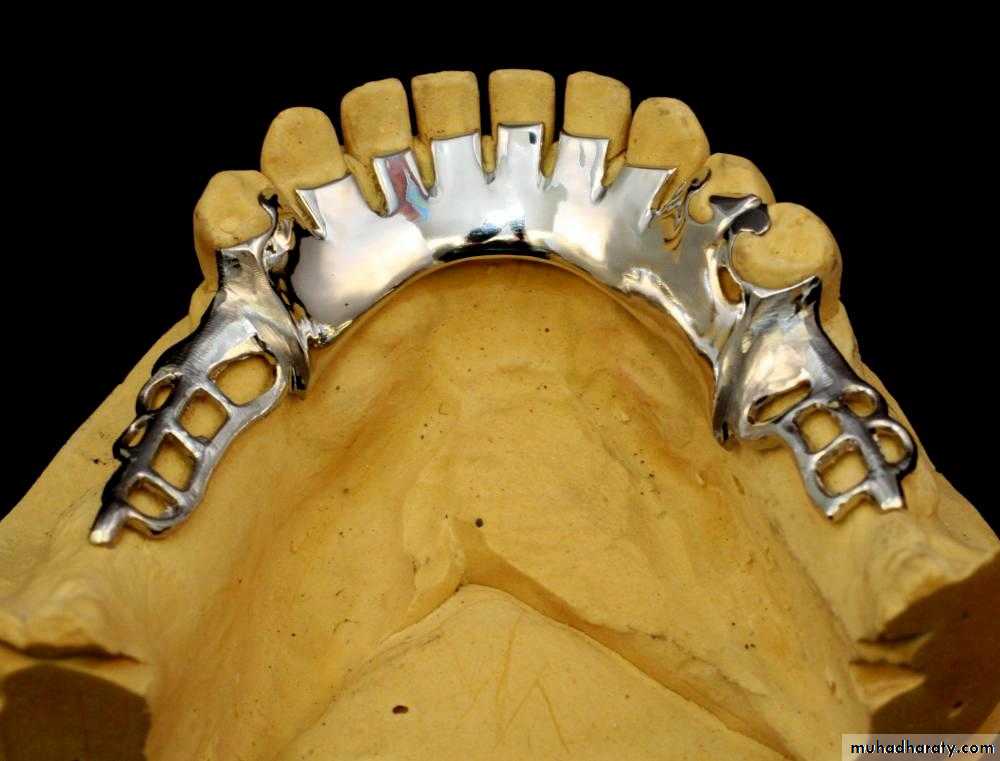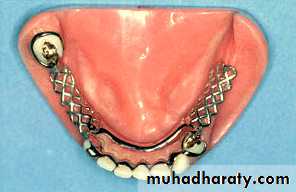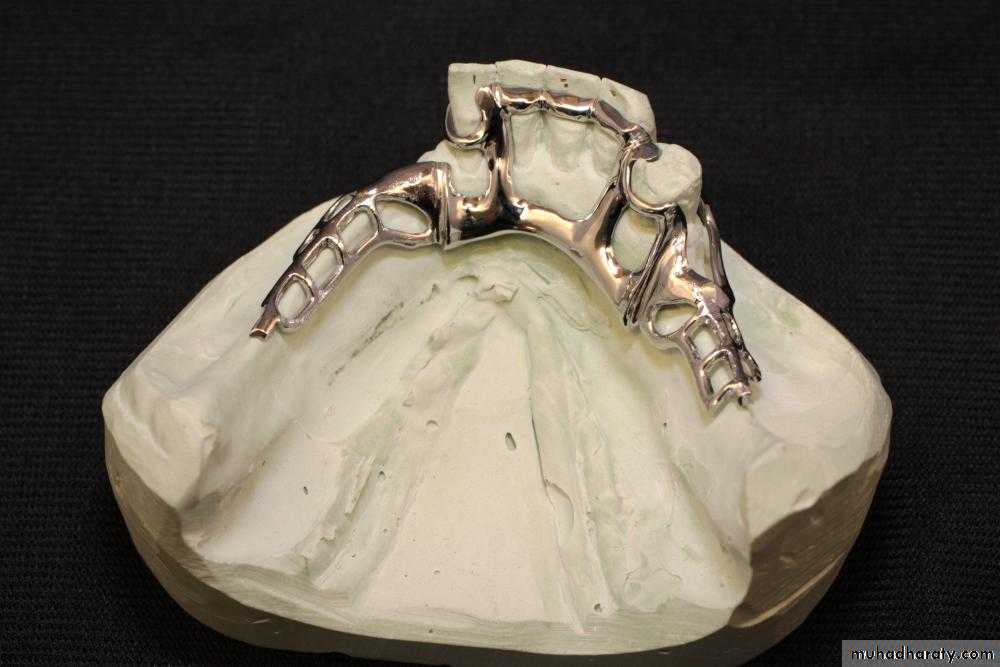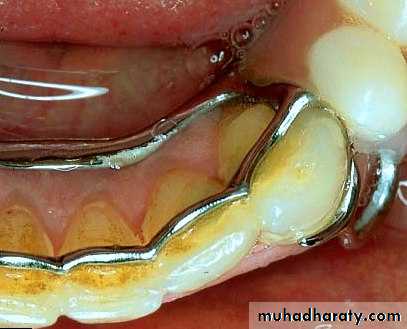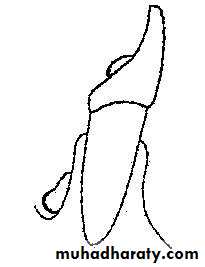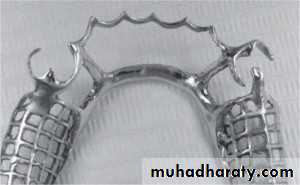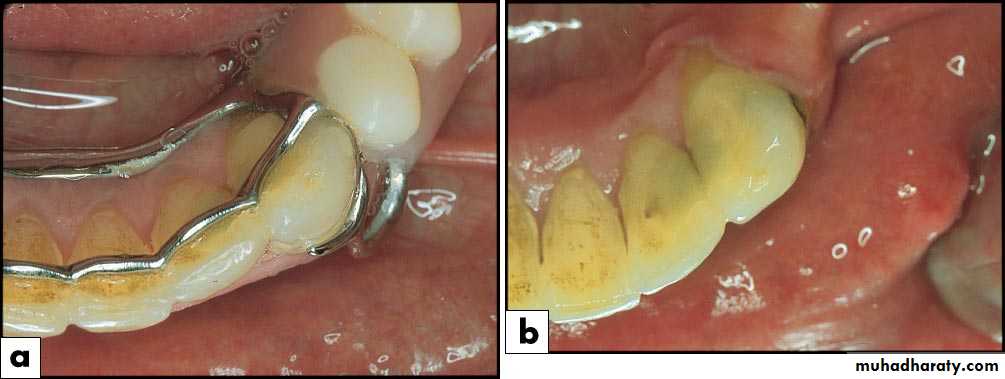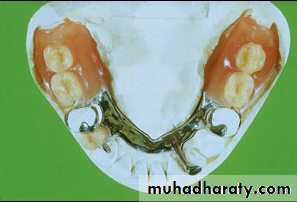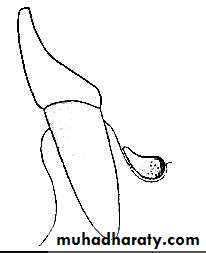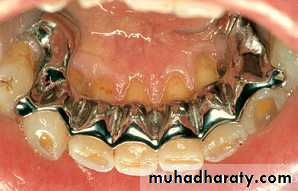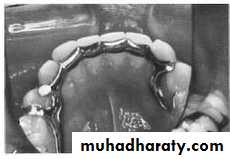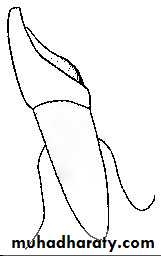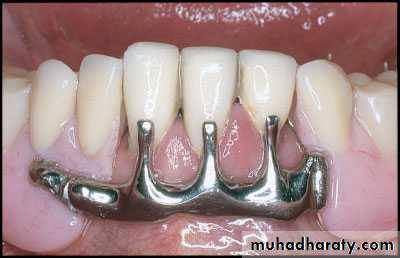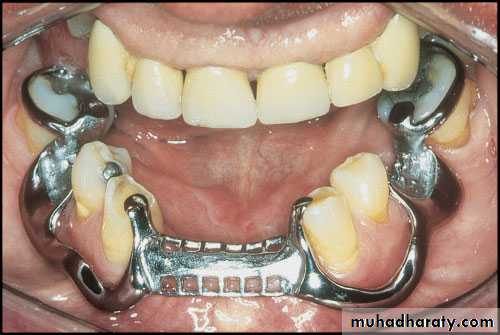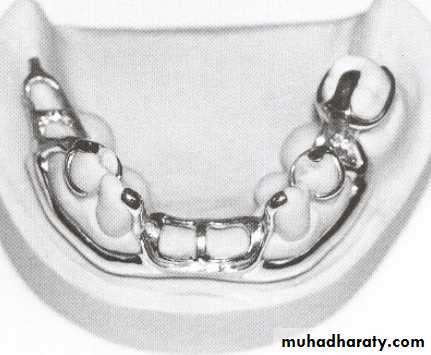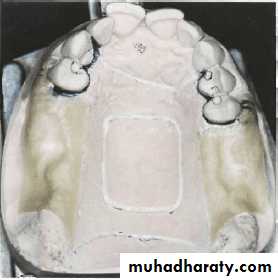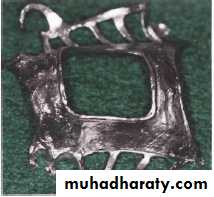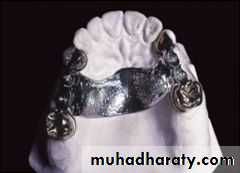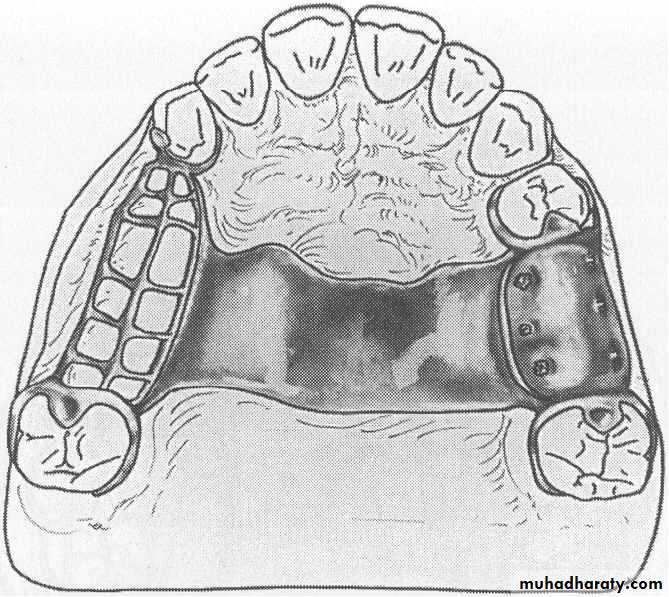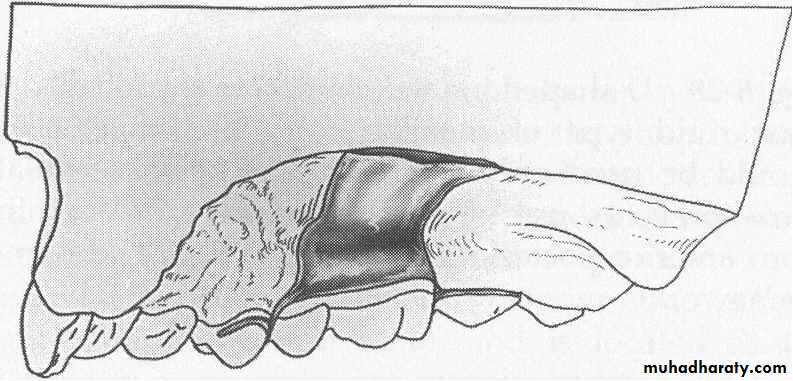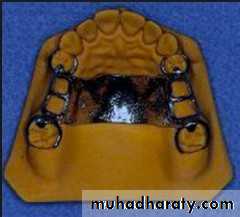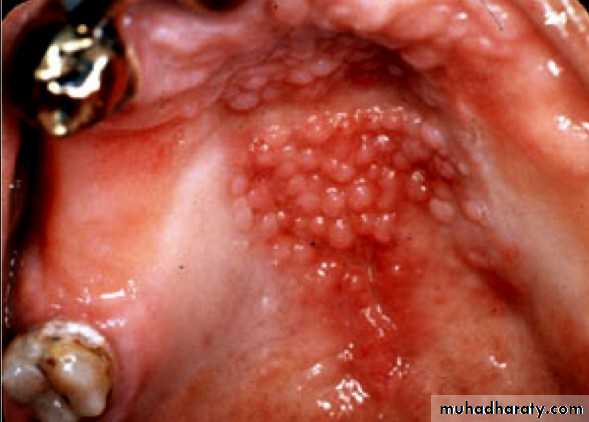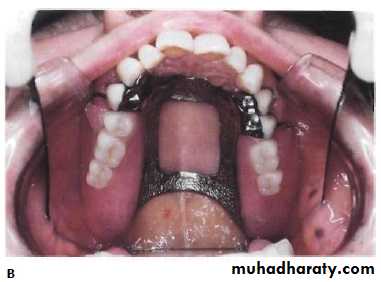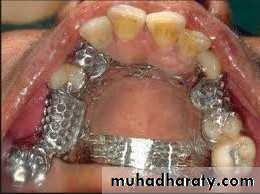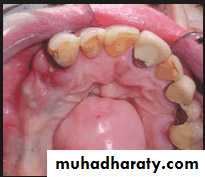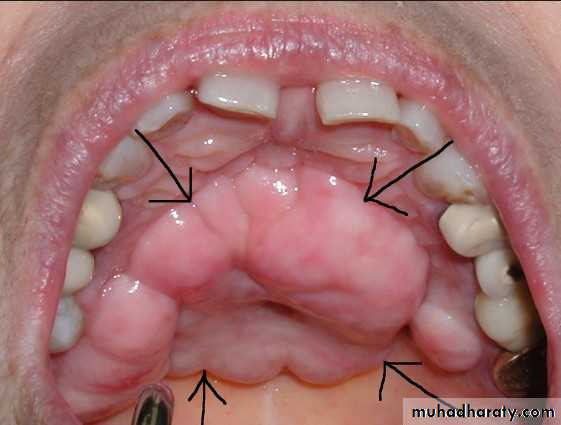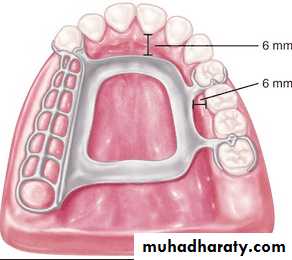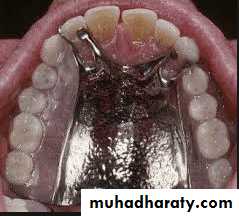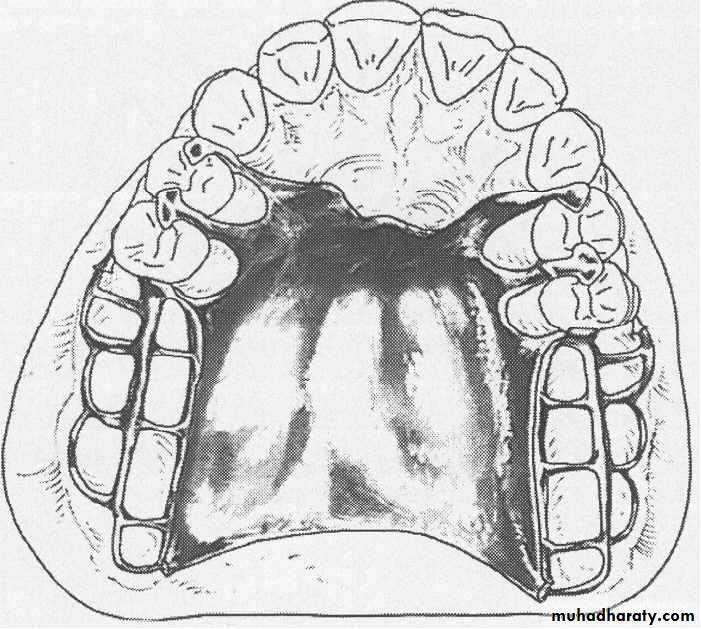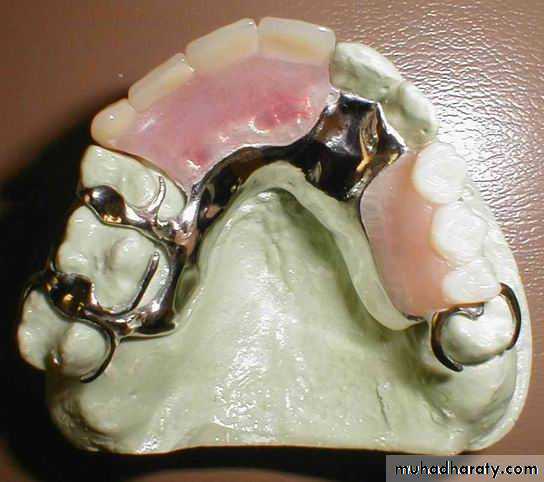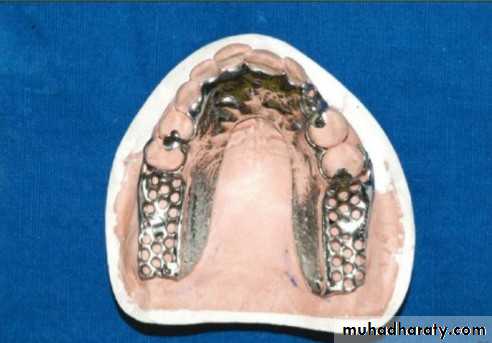Mandibular Major Connectorslec:2+3
Assis.Prof.Dr.Radhwan Himmadi Hasan
B.D.S , M.Sc. , Ph.D
2016-2017
11/19/2016
Assis.Prof.RadhwanHimmadi Hasan1
INTRODUCTION
• “No component of a Removable Partial Denture should be added arbitrarily or conventionally. Each component should be added for a good reason and to serve a definite purpose”.
• -WL McCracken
11/19/2016
Assis.Prof.RadhwanHimmadi Hasan2
Major Connector
• The part of a partial removable dental prosthesis that joins the components on one side of the arch to those on the opposite side
11/19/2016
Assis.Prof.RadhwanHimmadi Hasan3
Functions of major connector
Unification of the major parts of prosthesis.Distribution of applied force throughout the arch to selected teeth and tissue.
Minimization of torque to the teeth.
Provides cross arch-stability to help resist displacement by functional stresses.
Failure of major connector to provide rigidity may be manifest by
traumatic damage to periodontal support of abutment teeth,
injury to residual ridges, or
impingement of underlying tissue.
It is the dentist’s responsibility to ensure that the appropriate design and fabrication of the major connector are accomplished.
Basic requirements of Mandibular major connectors.
Rigid & provides cross-arch stability - broad distribution of stress.Should not interfere with & non irritating to the tongue.
Should not alter the contour of the lingual surface of the mandibular alveolar ridge.
Should not impinge on the oral tissues when the prosthesis is inserted or rotate in function.
11/19/2016
Assis.Prof.RadhwanHimmadi Hasan6
• Cover no more tissue than is absolutely necessary.
• Does not contribute to the retention or entrapment of food particles.• Has support from other elements of the framework to minimize rotational tendencies during function.
• Made from an alloy compatible with the oral tissues.
11/19/2016
Assis.Prof.RadhwanHimmadi Hasan
7
Design Specifications
Placement of borders: The superior borders are placed atleast 3 mm from the gingival margins.Relief: To prevent tissue impingement at rest & during function.
• Tooth-borne prostheses: 30 guage,0.010 inches.• Tooth/tissue-borne prostheses: More relief is required.
11/19/2016
Assis.Prof.RadhwanHimmadi Hasan8
Types Of Mandibular Major Connectors
11/19/2016Assis.Prof.RadhwanHimmadi Hasan
9
Lingual Bar Major Connector
Indications:
8mm vertical space between gingival margin and floor of the mouth.Lingual Bar
11/19/2016
Assis.Prof.RadhwanHimmadi Hasan10
Contraindications:
Inoperable lingual tori.
High lingual frenum attachment.
Interferences during functional movements
of the floor of the mouth .
Lingual Bar
11/19/2016
Assis.Prof.RadhwanHimmadi Hasan
11
Characteristics and location
Half-pear shaped with bulkiest portion inferiorly located.Superior border tapered to soft tissue.
Superior border located at least 3mm inferior to gingival margins.
Inferior border located at the ascertained height of the alveolar lingual sulcus when the patients tongue is slightly elevated.
Lingual Bar Major Connector
11/19/2016
Assis.Prof.RadhwanHimmadi Hasan12
At least 8mm of vertical space between the active tissues of the floor of the mouth and the gingival margins of the teeth is required.
.
Lingual Bar
11/19/2016Assis.Prof.RadhwanHimmadi Hasan
13
ADVANTAGES
DISADVANTAGESIt may be flexible if poorly constructed.
Rigidity is less compared to a well constructed lingual plate.Lingual bar connector has minimal tissue coverage and has minimal contact with oral tissues.
It does not contact the teeth, so decalcification of the tooth surface is minimized.
11/19/2016
Assis.Prof.RadhwanHimmadi Hasan
14
Lingual plate
Indications:
• High lingual frenum , shallow vestibule.
• Severe vertical resorption• Presence of lingual tori.
• Stabilization of periodontally weak teeth.
Contraindications:
In lingually inclined mandibular anterior teeth.
Wide embrassures and diastemaLinguoplate
11/19/2016
Assis.Prof.RadhwanHimmadi Hasan
15
Characteristics and location
Half-pear shaped with bulkiest portion inferiorly located.Thin metal apron extending superiorly to contact cingula of anterior teeth and height of contour of posterior teeth; and interproximally to contact points.
Scalloped contour of apron as dictated by interproximal blockout.
Linguoplate11/19/2016
Assis.Prof.RadhwanHimmadi Hasan16
The superior border should be knife edge and contoured to intimately contact lingual surface above the cingula.
Close inter proximal space to level of contact points.
Linguoplate
11/19/2016Assis.Prof.RadhwanHimmadi Hasan
17
ADVANTAGES
Provides more support and stabilization when compared to other connectors.Can be used in stabilizing the periodontally weakened teeth.
When it is supported at each end by a rest it contributes to the action of indirect retention.Provision to include more teeth in the design
Linguoplate
11/19/2016
Assis.Prof.RadhwanHimmadi Hasan18
DISADVATAGES
It covers the tooth structure and the gingival tissue.The metal coverage of the free gingival tissue prevents physiological stimulation and self-cleansing of these areas by saliva.
British Dental Journal 189, 414 - 424 (2000)
Linguoplate
11/19/2016Assis.Prof.RadhwanHimmadi Hasan
19
Interrupted Lingual Plate
It is a type of the lingual plate recommended in wide interproximal areas. Here the upper border of the lingual plate is cut longitudinally to prevent its display through the wider interproximal spacesLinguoplate Modifications
11/19/2016
Assis.Prof.RadhwanHimmadi Hasan20
Double lingual bar
• This type of major connector is also called “Kennedy bar” it distribute stresses to all of the teeth with which it comes in contact there by reducing the stresses to the underlying tissues.• It is also referred as “continuous lingual clasp” major connector, because of series of clasp arms connected on the lingual surfaces of lower anterior teeth.
Double Lingual Bar
11/19/2016Assis.Prof.RadhwanHimmadi Hasan
21
Characteristics and location
The lower component displays same charecteristics as that of a lingual bar.The upper bar should be half oval ,2-3mm in height and 1mm thick, presenting scallopped appearance.
Two bars joined by minor connectors on each end
Double Lingual Bar11/19/2016
Assis.Prof.RadhwanHimmadi Hasan
22
DISADVATAGES
Patient may feel discomfort because it alters the normal position of the tongue.If connector does not maintain intimate contact with tooth surface there will be food entrapment
Double Lingual Bar
11/19/2016
Assis.Prof.RadhwanHimmadi Hasan23
Sublingual Bar
• Indications
• The height of the floor of the mouth in relation to the free gingival margin is less than 6mm.
• If it is desired to keep the free gingival margins of anterior teeth exposed and there is inadequate depth of the floor of the mouth.
• Contraindications:
• Lingually tilted remaining natural teeth.
• Inoperable lingual tori.
• High attached lingual frenum.
Sublingual Bar
11/19/2016
Assis.Prof.RadhwanHimmadi Hasan24
Continuous bar (cingulum bar)
• Indication:• Improper axial alignment of the anterior teeth requiring excessive blockout of interproximal undercuts.
• Contraindications:
• In lingually tilted anterior teeth.
• Wide diastema between mandibular anterior teeth.
Cingulum Bar
11/19/2016
Assis.Prof.RadhwanHimmadi Hasan25
Characteristics and location
Thin narrow metal strap located on cingula of anterior teeth, scalloped to follow interproximal embrassures.Originates bilaterally from rests of the adjacent principle abutments.
11/19/2016
Assis.Prof.RadhwanHimmadi Hasan26
Labial Bar
Indication:
Large inoperable lingual tori.
Severe & abrupt lingual undercuts.
Lingually inclined lower anterior & premolars.
Labial Bar
11/19/2016
Assis.Prof.RadhwanHimmadi Hasan27
Characteristics and location
Half-pear shaped with bulkiest portion inferiorly located on the buccal aspect.Superior border tapered to soft tissue and 4mm inferior to labial gingival margins.
Inferior border located in the labial buccal vestibule; at the junction of attached & mobile mucosa.
Labial Bar
11/19/2016
Assis.Prof.RadhwanHimmadi Hasan28
Basic requirements of maxillary major connectors.
The same of Basic requirements of mandibular major connectors.Special structural requirements of Maxillary Major Connectors :
1- Intimate contact between the tissue side of the connector and the palatal tissues is required to enhance support, retention and stability of the partial denture. For this reason :a- Relief is avoided under maxillary major connectors.
b- The tissue side of the connector should not be highly polished during the final finishing and polishing procedures.c- Little relief may be only required in the presence of palatal tori or prominent median palatine raphe.
d- An effective specially prepared seal is required along all borders of maxillary major connectors that are in contact with soft tissues. This seal ensures intimate contact with the palatal tissues and prevents food debris from collecting under the connector. Beading of the maxillary cast is essential to develop this peripheral seal. This beading is prepared on the master cast by scrapping a shallow groove (0.5 mm in width and depth) along the borders of the connector.
2- All borders should be tapered slightly (beveled) towards the tissues so that they are less perceptible by the tongue. Borders should also be smoothly curved and should never be irregular.
3- The thickness of palatal plates should be uniform
TYPES OF MAXILLARY MAJOR CONNECTORS
Single palatal strapCombination anterior and posterior palatal strap-type connector
Palatal plate-type connector
U-shaped palatal connector
Single palatal bar
Anterior-posterior palatal bars
SINGLE PALATAL STRAP
Single Palatal Strap
Used to connect bilateral tooth-supported prosthesis, even those with short edentulous spaces, particularly when the edentulous areas are located posteriorly.It can be made rigid without objectionable bulk and interference with the tongue provided the cast framework material is distributed in three planes.
A
B
A, this single palatal strap type major connector is better suited for the restoration of short span tooth supported bilateral edentulous areas.
B, sagittal section. Midportion of major connector demonstrates slight elevation to provide rigidity. Such thickness of major connector does not appreciably alter palatal contours.
To be rigid enough to resist torque and provide adequate vertical support and horizontal stabilization, a single palatal strap would have to be objectionably bulky. When placed anteriorly, the bulk would become even more objectionable to the patient interfering with speech.
More frequently used in class III situations.
Disadvantages
• 1- Pt. complaint from• excessive palatal
• coverage:
• a) Anterior border:
• Posterior to palatal
• ruga or at the posterior
• slope of prominent
• ruga.
• b) Posterior border:.
• Anterior to junction of
• The Hard & The Soft
• palate.
• 2- ↑ Soft tissue coverage
• ↓
• (Papillary hyperplasia)
• a) Denture wearing 24
• hour daily.
• b) Poor oral hygiene.
• c) Inadequate Pt.instru.
• instructions.
COMBINATION ANTERIOR AND POSTERIOR PALATAL STRAP-TYPE CONNECTOR
Combination Anterior and Posterior Palatal Strap-type Connector
Structurally a rigid major connector.May be used in any maxillary partial denture design.
Posterior palatal strap :
Design- flat and minimum 8 mm wide.
Location- as far posteriorly as possible to avoid interference with tongue but anterior to line of flexure formed by the junction of hard and soft palates.
Anterior component is a flat strap located as far posteriorly as possible to avoid rugae coverage and tongue interference. Anterior border of this strap should be located just posterior to a rugae crest or in the valley between two crests. Posterior strap is thin, a minimum of 8 mm wide, and Is located as far posteriorly as possible, yet entirely on hard palate. It should be located at right angles to midline rather than diagonally.
Contraindication: inoperable maxillary torus that extends posteriorly to soft palate (a broad U-shaped major connector is used).
Strength: lies in the fact that anterior and posterior components are joined together by longitudinal connectors on either side, forming a square or rectangular frame. Each component braces the others against possible torque and flexure.
Use: used most frequently in classes II and IV.
All maxillary major connectors should cross the midline at a right angle rather than on a diagonal.
Palatal Plate-type Connector
Thin, broad, contoured palatal coverage, covering one half or more of the hard palate.Palatal major connector covering one half or more of the hard palate. Anterior border follows valleys between rugae and does not extend anterior
. Posterior border is located at junction of hard and soft palates but does not extend onto soft palate.
Horseshoe connector
• - Thin band of metal
• running along the lingual
• surfaces of the remaining
• teeth& extended onto the
• palatal tissues for 6-8 mm.
• - Rigidity can increased by
• extending the borders
• slightly onto the horizontal
• surfaces of the hard palate.
• - Should display symmetry
• - Should extend to the
• same height on both sides.
• - All borders should be
• gently curved& smooth.
disadvantages
1- Tendency for theconnector to flex or
deform.
↓
(Stress concentration)
↓
(Abutment damage)
2- To avoid flexing, It
should be thicker than
other major connectors.
(↑ bulk)
↓
(Pt. discomfort&
affecting Phonetics)
Review of Indications of Maxillary Major Connectors:
1- If the periodontal support of the remaining teeth is weak → more of the palate should be covered → A wide palatal strap or a complete palate is indicated.
2- If the remaining teeth have adequate periodontal support and little additional support is needed → a palatal strap or antero-posterior palatal bar may be used.
3- For long-span distal extension bases where rigidity is critical → an antero-posterior palatal strap or complete palate is indicated.
4- When anterior teeth must be replaced → an antero-posterior palatal strap, complete palate, or horseshoe major connector may be used. The final selection must be based on modifying factors such as:
a- number and location of missing posterior teeth. b- periodontal support of remaining teeth.
c- type of opposing occlusion.
5- If a torus is present and is not to be removed → an anteroposterior palatal strap, antero-posterior palatal bar, or horseshoe major connector may be used.
6- A horseshoe connector should be used very sparingly
7- A palatal bar is rarely indicated.
Review for indications for mandibular major connector:
1- For tooth supported RPD → Lingual bar.2- Insufficient room between floor of the mouth and gingival margins or large tori → Lingual plate.
3- Low periodontal support for anterior teeth → Lingual plate.
4- Low periodontal support for anterior teeth with wide embrasures → Interrupted Lingual Plate, or double lingual bar.
5- Replacement of all posterior teeth → Lingual plate.
6- Labial bar is rarely indicated.

